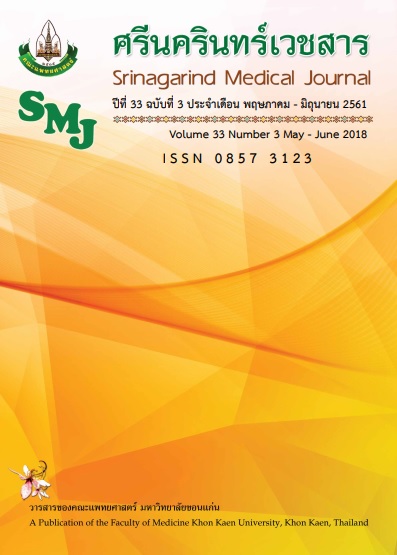Comparison of Respiratory Muscle Strength between Native Lowlands and Native Highlands Populations in Chiang Rai
Abstract
Background and Objectives: Living in highlands and lowlands could affect anatomical and physiological changes of respiratory system. Therefore, it is possible that people live in both regions might have different of respiratory muscle strength. However, there was no study conducted on the different of respiratory muscle strength between both highlands and lowlands populations in northern Thailand. This study aimed to compare the respiratory muscle strength between native lowlands and native highlands in Chiang Rai province, northern Thailand.
Materials and methods: Forty four participants were recruited from Chiang Rai. Twenty two participants were native highland populations from the Li Kai hilltribe in Nanglae subdistrict and twenty two participants were native lowlands populations live in Mueang Chiang Rai district. All participants were assessed for maximal inspiratory pressure starting from residual volume (PImaxRV), maximal inspiratory pressure starting from functional residual capacity (PImaxFRC) and maximal expiratory pressure (PEmax) by Micro Medical respiratory pressure meter (portable handheld). Independent t-test was used to analyze in all outcomes. The levels of statistical significance at p < 0.05
Results: The results showed PImaxRV (134.45 ± 27.64 cmH2O) and PImaxFRC (131.73 ± 28.26 cmH2O) in male native highlands populations were significant higher than male native lowlands populations (PImaxRV 110.73 ± 19.12 cmH2O and PImaxFRC 104.55 ± 20.79 cmH2O).
Conclusion: The study revealed that male native highlands populations have respiratory muscles strength more than male native lowlands populations whereas female native highlands populations tend to have respiratory muscles strength more than female native lowlands populations.
เปรียบเทียบความแข็งแรงของกล้ามเนื้อหายใจของคนปกติที่อาศัยอยู่ในที่ราบกับคนพื้นถิ่นชาวเขาที่อาศัยอยู่ที่สูงในจังหวัดเชียงราย
อ้อมขวัญ ทิมินกุล*, คทาวุธ ผิวจินดา, วิลาวัณย์ ไชยอุต
สาขากายภาพบำบัด สำนักวิชาวิทยาศาสตร์สุขภาพ มหาวิทยาลัยแม่ฟ้าหลวง
หลักการและวัตถุประสงค์ : การอาศัยอยู่บนพื้นที่สูงและพื้นที่ราบมีผลต่อการเปลี่ยนแปลงทั้งทางกายวิภาคศาสตร์และสรีรวิทยาของระบบหายใจ ซึ่งอาจเป็นไปได้ว่าประชากรในทั้งสองพื้นที่ จะมีความแข็งแรงของกล้ามเนื้อหายใจที่แตกต่างกัน แต่อย่างไรก็ตามยังไม่เคยมีการศึกษาความแตกต่างระหว่างความแข็งแรงของกล้ามเนื้อหายใจของผู้ที่อาศัยอยู่บนพื้นที่สูง และผู้ที่อาศัยอยู่บนพื้นที่ราบในจังหวัดเชียงราย ดังนั้นการศึกษานี้จึงมีวัตถุประสงค์เพื่อเปรียบเทียบความแข็งแรงของกล้ามเนื้อหายใจในประชากรที่อาศัยอยู่บนพื้นที่สูง กับประชากรที่อาศัยอยู่บนพื้นที่ราบในจังหวัดเชียงราย
วิธีการศึกษา: การศึกษานี้ทำในกลุ่มอาสาสมัครจำนวน 44 ราย ในจังหวัดเชียงราย โดย 22 ราย เป็นคนพื้นถิ่นชาวเขา หมู่บ้านลิไข่ ตำบล ตำบลนางแล อำเภอเมือง จังหวัดเชียงราย และ อีก 22 ราย เป็นผู้ที่อาศัยอยู่บนพื้นราบ อำเภอเมือง จังหวัดเชียงราย ผู้วิจัยทำการวัดค่าความดันขณะหายใจเข้าสูงสุดโดยการวัด (PImaxFRC, PImaxRV) และทำการวัดค่าโดยวัดค่าความดันขณะหายใจออกสูงสุด (MEP) โดยใช้เครื่อง Micro Medical respiratory pressure meter (portable handheld) และทำการเปรียบเทียบความแตกต่างของแต่ละตัวชี้วัดด้วยสถิติ Independent t-test โดยตั้งระดับนัยสำคัญอยู่ที่ p < 0.05
ผลการศึกษา: พบว่า ค่า Pimax Rv (134.45 ± 27.64 cmH2O) และ Pimax FRC (131.73 ± 28.26 cmH2O) ในกลุ่มอาสาสมัครชายพื้นถิ่นชาวเขาสูงกว่า กลุ่มอาสาสมัครชายที่อาศัยอยู่บนพื้นราบอย่างมีนัยสำคัญทางสถิติ (Pimax Rv 110.73 ± 19.12 cmH2O และ Pimax FRC 104.55 ± 20.79 cmH2O)
สรุป : การศึกษานี้พบว่าชายพื้นถิ่นชาวเขามีกล้ามเนื้อหายใจที่แข็งแรงกว่าชายที่อาศัยอยู่บนพื้นราบ ขณะที่กลุ่มอาสาสมัครหญิงพื้นถิ่นชาวเขาพบว่ามีแนวโน้มมีความแข็งแรงของกล้ามเนื้อหายใจมากกว่าอาสาสมัครหญิงที่อาศัยอยู่บนพื้นราบ
References
2. Hurtado A. Studies at high altitude. Blood observations on the Indian natives of the Peruvian Andes. Am J Physiol 1932; 100: 487-505.
3. Frisancho AR. Developmental adaptation to high altitude hypoxia. Int J Biometeorol 1977; 21: 135-46.
4. Frisancho AR, Velasquez T, Sanchez J. Influence of developmental adaptation on lung function at high altitude. Hum Biol 1973; 45: 583-94.
5. Greksa LP, Spielvogel H, Caceres E. Total lung capacity in young highlanders of Aymara ancestry. Amer J Physical Anthro 1994; 94: 477-86.
6. Buranapuntalug S, Jalayondeja W, Chaunchaiyakul R. Effectiveness of respiratory resistance training device on respiratory muscles strength and endurance. J Med Tech PhyTher 2013; 25: 182-92.
7. Promsrisuk T, Khrisanapant W, Suttitum T, Pasurivong O. Respiratory Muscle Strength in Elderly Thais. Graduate research conference 2013: 783-90.
8. Koller EA, Lesniewska B, Buhrer A, Bub A, Kohl J. The effects of acute altitude exposure in Swiss highlanders and lowlanders. Eur J Appl Physiol Occup Physiol 1993; 66: 146-54.
9. Droma T, McCullough RG, McCullough RE, Zhuang JG, Cymerman A, Sun SF, et al. Increased vital and total lung capacities in Tibetan compared to Han residents of Lhasa (3,658 m). Am J Phys Anthropol 1991; 86: 341-51.
10. Cerny FC, Dempsey JA, Reddan WG. Pulmonary gas exchange in nonnative residents of high altitude. J Clin Invest 1973; 52: 2993.
11. DeGraff AC, Grover RF, Johnson RL, Hammond JW, Miller JM. Diffusing capacity of the lung in Caucasians native to 3,100 m. J Appl Psychol 1970; 29: 71-6.
12. Dumrongchua J, Khrisanapant W, Tunkamnerdthai O. Respiratory muscle strength and pulmonary function in sedentary Thais. Graduate research conference 2012: 829-37.
13. Hoit BD, Dalton ND, Erzurum SC, Laskowski D, Strohl KP, Beall CM. Nitric oxide and cardiopulmonary hemodynamics in Tibetan highlanders. J Appl Physiol 2005; 99: 1796-801.
14. Hostler D, Schwirian CI, Campos G, Toma K, Crill MT, Hagerman GR, Hagerman FC, Staron RS. Skeletal muscle adaptations in elastic resistance-trained young men and women. Eur J Appl Physiol 2001; 86: 112-8.
15. Greksa LP, Spielvogel H, Caceres E. Total lung capacity in young highlanders of Aymara ancestry. Am J Phys Anthropol 1994; 94: 477-86




